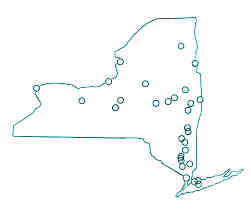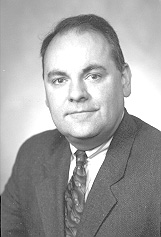| The Officers Club |
| |
| at Fort Niagara State Park |
The Recent History of the Officers Club
The State of New York maintains some 152 State Parks and 35 Historic Sites. All of these are administered by the State's Office of Parks, Recreation and Historic Preservation (OPRHP}. The Officers Club is located in Fort Niagara State Park and thus falls under the purview of OPRHP, that is, it administers the building on behalf of the State and People of New York State and has the power to decide what happens to it.
The following is a chronicle of the events that preceded the decision by OPRHP that the Officers Club should become a Museum and conference facility:
1996: OPRHP decides that the Officers Club and three other building will be leased for "adaptive reuse." The four buildings have been closed to the public and maintained virtually empty ever since the Army decommissioned Fort Niagara in 1963.
|
|
1997: OPRHP accepts a proposal submitted by Mr. W. Kirk Hastings on behalf of Construction Services of Niagara, Inc. It envisages transformation of the Officers Club into a restaurant. Historian David L. Dickinson, writing an article about the POW camp that existed at the Fort during WWII, rediscovers that the Officers Club contains four, by then forgotten, historical murals. He conducts extensive research of the Officers Club and its murals. It reveals that building and its murals have a much more important history than previously realized.
1998: On March 4, the OPRHP conducts a Public Information/Scoping Meeting at Porter Town Hall. Porter is the Township where both the Fort Niagara State Park and the Village of Youngstown are located. At a packed meeting, major concerns are expressed regarding the fate of the Officers Club and its murals. A major public information campaign is mounted by Mr. Dickinson, other interested individuals and several organizations, including the Polish Arts Club of Buffalo and The Retired Officers Association - all loosely organized as the Officers Club Museum Coalition (OCMC) - aimed at having the OPRHP exclude the Officers Club from the lease and to preserve it as a museum and a historic site.
|
|
1998:On April 10, in written comments submitted to OPRHP by the Polish Arts Club of Buffalo, the point is made that, although the Niagara Frontier played a significant part in the State's history, the geographical distribution of the State's Historical Sites is extremely lopsided, as shown by the map. Nor, it is argued, could that paucity of New York State Historical Sites be attributed to a lack of historic buildings or sites worthy of such designation. Contrast the one such site on the American side of the Niagara River with the five Historical Sites on the Canadian side. The further point is made that Historic Sites attract visitors and spur interest in the area and that while the Canadian side of the river is booming, the American side is economically depressed, circumstances not unrelated to the State's lack of development of Historical Sites on Niagara Frontier.
1998:On November 9, OPRHP issues a Draft Environmental Impact Statement. In it, the reuse of the Officer's Club as a Museum/Conference Center is described as the preferred alternative. A second public hearing is held on December 2. Removal of the Officers Club from the contract with Construction Services of Niagara, Inc. is voiced. Some suggest that the OPRHP assume responsibility for the protection and use of the building as a Museum. Others suggest OPRHP work closely with a not-for-profit entity or Friends Group.
|
|
1999: On April 29, the OPRHP issues a Final Environmental Impact Statement which concludes that the Officers Club should become a Museum and conference facility. It indicates that OPRHP has met with the Old Fort Niagara Association (OFNA), "with whom it has contracted for many years with respect to the care and interpretation and use of historic resources at Fort Niagara State Park," to discuss future programming for the Officers Club." In consequence of these discussions, OPRHP states that it "will amend its agreement with OFNA to place the Officers Club under the OFNA area of responsibility."
2000: OFNA invites OCMC and other interested individuals to participate in a strategic planning process whose goal is to chart the route that need to be followed for the Officers Club to become a state-of-the-art Museum. A $5 million fund-raising campaign, half to be sought from NY State budgetary allocation, to develop the Officers Club and Visitors Center is announced. In the interim, it agreed upon that, utilizing OCMC-recruited volunteers and OCMC-generated temporary exhibits, the Officers Club will be open on one afternoon a week during the forthcoming Summer months. This is viewed as essential component of the continuing public information campaign necessary for the fund-raising effort to meet with success.
| OFFICERS CLUB SITE MAP |
| FORT NIAGARA STATE PARK | OLD FORT NIAGARA |
| Info-Poland a clearinghouse of information about Poland, Polish Universities, Polish Studies, etc. |


